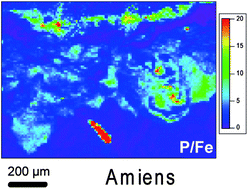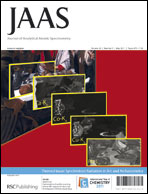X-ray absorption spectroscopy study of the various forms of phosphorus in ancient iron samples†
Abstract
Several ancient world heritage iron-based structures present quite good corrosion resistance that is generally related to the presence of phosphorus in their metallic substrate. However, the exact protection mechanisms have not yet been explained. In order to better understand the role of this element, in the conditions of atmospheric corrosion, both its distribution and speciation were investigated. To do so, a combination of microXRF and microXANES at the P K-edge was used, together with micro-Raman investigations. This methodology was applied on two types of ancient ferrous samples. For both types, two sources of phosphorus, global endogenous as well as localised exogenous were revealed. From these two sources, the phosphorus was seen to be heterogeneously distributed in the corrosion products. The shape of the XANES spectra demonstrated that the phosphorus is present as phosphate complexes with all the iron corrosion products present in the layers.

- This article is part of the themed collection: Synchrotron Radiation in Art and Archaeology

 Please wait while we load your content...
Please wait while we load your content...